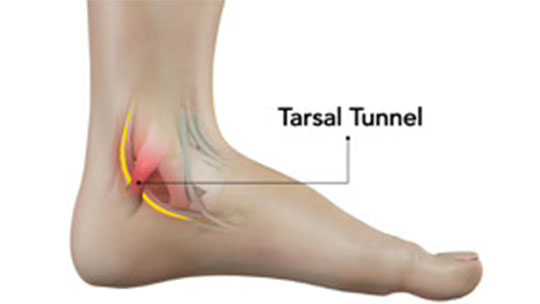Tarsal Tunnel Syndrome
Tarsal Tunnel Syndrome is a painful condition of the foot where the tibial nerve experiences too much pressure inside the tarsal tunnel. The excess pressure is translated by the brain into pain which is felt along the toes, bottom of the foot, and heel. A damaged nerve can also lead to loss of sensation in the toes and foot.
WHAT CAUSES TARSAL TUNNEL SYNDROME?
Tarsal Tunnel Syndrome is caused by trauma or too much pressure to the tibial nerve which is located in the foot’s tarsal tunnel. This can be caused by something as simple as Flatfoot, an Ankle Sprain, or Ankle Arthritis.
HOW DO I KNOW IF I HAVE TARSAL TUNNEL SYNDROME?
WHAT ARE THE SYMPTOMS OF TARSAL TUNNEL SYNDROME?
The symptoms of Tarsal Tunnel can be felt inside the ankle, along the bottom of the foot, toes, heel, or the arch of your foot. These symptoms include numbness in the foot and sometimes the leg, pain that ranges from a dull ache to a sharp, shooting sensation. Symptoms are often aggravated by activity and relieved by rest, although some patients complain of “burning” or “tingling” at night.
HOW IS TARSAL TUNNEL SYNDROME DIAGNOSED?
Tarsal Tunnel Syndrome is diagnosed by a visit to your local doctor or podiatrist where he or she will physically examine your foot, ankle, and leg. Your doctor may also order X-rays and/or a nerve conduction study to test the nerve.
WHAT CAN I DO FROM HOME FOR TARSAL TUNNEL SYNDROME?
WHAT CAN I DO TO PREVENT TARSAL TUNNEL SYNDROME?
There are several things you can do to prevent Tarsal Tunnel Syndrome. You can make sure that your shoes fit correctly. This means wearing shoes that are roomy, fit well, and do not pinch or squeeze your feet. Also, allowing your foot plenty of rest-time between activity is a vital way you can keep your foot from becoming over-worked and tired. Warm up your muscles before beginning any type of physical activity.
WHAT TREATMENTS CAN I DO FROM HOME FOR TARSAL TUNNEL SYNDROME?
You can help manage your Tarsal Tunnel Syndrome from home by giving your foot plenty of rest, applying ice, and keeping your ankle wrapped. Relieving your foot of weight and pressure helps your ankle heal faster.
WHEN SHOULD I SEE A DOCTOR FOR TARSAL TUNNEL SYNDROME?
You should see a doctor for Tarsal Tunnel Syndrome as soon as you suspect you have it. This condition can worsen over time if not treated and can lead to permanent nerve damage.
TREATMENTS YOUR DOCTOR MAY RECOMMEND FOR TARSAL TUNNEL SYNDROME
Unlike other nerve-related conditions, you can fully recover from Tarsal Tunnel Syndrome. The treatments available for Tarsal Tunnel Syndrome are as follows:
Non-Surgical:
- Rest – Get off your injured foot as soon as possible. Relieving weight and pressure will help your foot heal faster and avoid further injury.
- Ice – Rest or wrap your injured foot with ice as soon as possible. Ice helps prevent swelling and promotes faster healing time. Wrap the ice in a towel and avoid putting ice directly on the skin.
- Compress – Immobilize the injured foot with a bandage or ankle brace. This gives your ankle stability and protects it from further injury. Make sure you don’t wrap your foot or ankle too tightly. You don’t want to cut off the blood supply to your foot.
- Anti-inflammatory medications. These can help reduce inflammation, swelling, and pain.
- Wear supportive shoes. Wearing shoes with sufficient arch support can help to relieve pressure on the tibial nerve.
Surgical:
One of your treatment options is tarsal tunnel surgery. During the surgery your tarsal tunnel is enlarged which then allows your foot the ability to handle more pressure without damaging your nerves.

